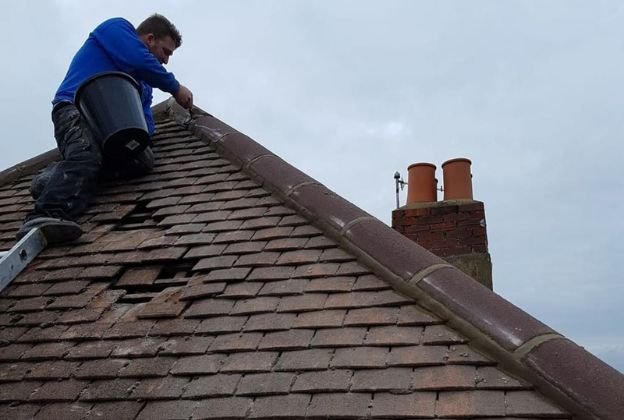Comprehending the Various Types of Roofing Systems: A Comprehensive Overview for Homeowners
In the world of homeownership, choosing the proper roof covering design is a choice that lugs substantial implications for both functionality and visual charm. With an array of alternatives-- varying from the conventional gable to the modern level-- each kind offers one-of-a-kind advantages and obstacles that should line up with the homeowner's ecological factors to consider and certain demands. Recognizing these differences not only help in making an educated option yet likewise affects long-lasting maintenance and energy effectiveness. As we explore the complexities of various roof kinds, it ends up being evident that a person size does not fit all; the appropriate selection might shock you.
Saddleback Roof
Gable roofs, characterized by their triangular form, are among one of the most preferred roofing styles as a result of their simpleness and effectiveness in dropping water and snow. This design includes 2 sloping sides that meet at a ridge, permitting reliable water drainage and lessening the danger of water build-up. The high pitch commonly connected with saddleback roofs enhances their ability to manage hefty precipitation, making them appropriate for numerous environments.
Along with their useful benefits, gable roofing systems use visual flexibility. They can be adapted to different architectural designs, from typical to modern homes. The design can likewise suit extra functions such as dormer windows, which boost all-natural light and ventilation in the attic area.
Moreover, saddleback roofs provide sufficient area for insulation, contributing to power performance. Home owners can select from a range of roof covering products, including asphalt roof shingles, metal, and floor tiles, further boosting customization options.
Regardless of their advantages, saddleback roofs might call for extra assistance in areas susceptible to high winds or hefty snowfall. Generally, the saddleback roof remains a favored selection because of its blend of performance, sturdiness, and visual charm.
Flat Roofs
Level roofs are often acknowledged for their minimal layout and useful applications, specifically in commercial and commercial setups (oahu roofing). These roofs include a almost horizontal or straight surface area, which allows for very easy building and versatile room utilization. While they may do not have the visual charm of pitched roofs, level roofs use numerous benefits, particularly in metropolitan environments where making the most of room is vital
One of the primary advantages of level roof coverings is their availability. House owners can utilize the roofing system room for various functions, such as rooftop yards, terraces, or solar panel setups. In addition, flat roofs are typically extra cost-effective to preserve and install contrasted to their sloped equivalents, as they call for fewer materials and labor.
Nonetheless, level roofs do present particular challenges. Appropriate drain is necessary to avoid water merging, which can bring about leakages and architectural damage. Thus, picking top quality waterproofing products and regular inspections are crucial for making certain long life. Common materials utilized for level roofing systems consist of built-up roofing (BUR), changed asphalt, and single-ply membrane layers, each offering distinct benefits. In general, level roofings function as a adaptable and practical choice for many house owners and organizations alike.
Hip Roofs
Hip roof coverings are defined by their sloped sides that merge at the top, developing a ridge. This design is distinct from gable roofs, as all 4 sides of a hip roof slope downwards toward the walls, giving a much more steady structure. The angle of the slopes can vary, permitting for adaptability in architectural looks and performance.
One of the primary advantages of hip roofings is their ability to stand up to heavy winds and adverse climate conditions. The sloped surface areas make great post to read it possible for much better water drain, lowering the risk of leaks and water damage. Furthermore, hip roof coverings provide increased attic room space, which can be utilized for storage or perhaps transformed right into livable areas.
Nonetheless, constructing a hip roof covering can be a lot more complicated and pricey than easier roof kinds, such as gable roofing systems. The extra material and labor included in producing the inclines and making certain appropriate architectural honesty can bring about higher costs. Despite these disadvantages, many homeowners prefer hip roofings for their toughness, visual appeal, and possibility for energy effectiveness.
Mansard Roof Coverings
Mansard roofing systems, often recognized by their distinct four-sided design, function 2 inclines on each side, with the lower incline being steeper than the upper. This building style, stemming from France in the 17th century, is not only visually enticing however useful, as it takes full advantage of the functional room in the upper floors of a structure. The high reduced incline permits even more headroom, making it a suitable choice for lofts or attics, which can be transformed right into living rooms.
Mansard roofing systems are defined by their versatility, suiting various architectural styles, from standard to modern-day. They can be built with various materials, including asphalt roof shingles, slate, or metal, giving homeowners with a series of choices to suit their spending plans and preferences. In addition, the layout enables the combination of dormer windows, improving all-natural light and air flow in the top levels.
Nonetheless, it is necessary to think about the potential downsides. Mansard roofing systems may require even more upkeep due to the complexity of their design, and their steep slopes can be challenging for snow and rainfall drainage. Generally, mansard roofings incorporate sophistication with functionality, making them a prominent option among property owners looking for distinctive architectural functions.
Lost Roofs
As homeowners progressively seek simplicity and functionality in their building designs, shed roofing systems have actually become a preferred choice. Defined by a solitary sloping aircraft, a shed roof covering provides a minimalist aesthetic that complements various home designs, from contemporary to rustic.
Among the primary benefits of a shed roofing is its simple building, which frequently translates to lower labor and product costs. This style enables effective water drain, minimizing the risk of leakages and water damages. Additionally, the vertical slope supplies enough area for skylights, boosting all-natural light within the interior.
Lost roof coverings additionally provide adaptability in terms of use. They can be properly integrated right into enhancements, garages, or outside structures like pavilions and sheds. In addition, this roofing system design can accommodate various roof covering materials, including metal, asphalt shingles, or find out also green roofings, straightening with eco-friendly campaigns.
However, it is necessary to consider local environment problems, as heavy snow tons may demand changes to the roofing's angle or structure. On the whole, lost roofing systems offer a useful and aesthetically pleasing alternative for property owners looking to take full advantage of capability without jeopardizing design.
Verdict


Gable roofs, defined by their triangular shape, are amongst the most prominent roof covering styles due to their simplicity and efficiency in losing water and snow. oahu roofing. The steep pitch generally connected with gable roofs improves their capacity to handle hefty rainfall, making them suitable for numerous environments
While they may do not have the visual appeal of pitched roof coverings, level roofing systems supply numerous benefits, particularly in urban settings where making the most of space is crucial.

 Alisan Porter Then & Now!
Alisan Porter Then & Now! Andrea Barber Then & Now!
Andrea Barber Then & Now! Christina Ricci Then & Now!
Christina Ricci Then & Now! Marcus Jordan Then & Now!
Marcus Jordan Then & Now! Stephen Hawking Then & Now!
Stephen Hawking Then & Now!